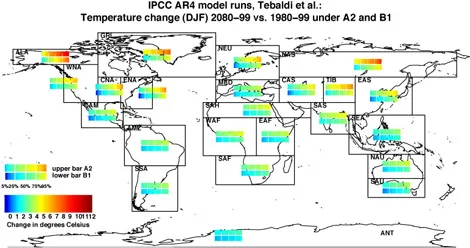Claudia Tebaldi - Statistician
Crunching the numbers of climate change

Claudia Tebaldi
Carlye Calvin, UCAR
Claudia Tebaldi jokes that if different climate models were all in agreement with each other, she wouldn't have a job. A statistician by training, Claudia analyzes results from climate models to assess the degree of uncertainty in their predictions.
"The nice thing about working at NCAR is that there is so much data," she says. "Wherever there is data, you can apply statistics."
Claudia focuses on what are known as general circulation climate models. Scientists use these complex numerical models to predict how the world's climate will change over coming decades and centuries. The models incorporate physical laws into their calculations to simulate the processes that control Earth's climate. But these global models must make approximations because their scales are not fine enough to represent many details. This is one reason why different models produce different future projections.
"Every model contributes something to the story and no model is the 'true model,' " Claudia says. "We look at models that give us different numbers and we have to make sense of them."
To make sense of the numbers, Claudia applies statistics to determine the likelihood of various outcomes, using records of Earth's past and present climate for comparison and validation. One of her studies, for example, focused on heat waves. Using a general circulation model, she and NCAR scientist Jerry Meehl found that the greenhouse gases responsible for global warming intensify atmospheric circulation patterns that have been observed during heat waves in Europe and North America. Using Chicago and Paris as examples, their study projects that the average number of heat waves in Chicago will increase in the coming century by 25%, and in Paris by 31%. Heat waves will also last several days longer in both cities.
Claudia's role in the study was to create a statistical definition of heat waves, quantify comparisons between real, observed heat waves and the model's simulated heat waves, and compute future changes and their significance. Jerry attributed scientific interpretation and meaning to her numbers.
"This was not a sophisticated study from a statistical perspective, but it received a lot of press because of the potential impacts on human health and ecosystems," Claudia says. As a result of the work, she was called to testify before the U.S. Senate Committee on Commerce, Science, and Transportation during a hearing on climate change impacts.
One of Claudia's favorite things about her job is working closely with the scientists who interpret the data that she analyzes. "Because I'm a statistician, I couldn't be anything but a team player," she points out. "My job always involves interesting people from all over NCAR."
She also appreciates the fact that her work has practical implications, particularly because she's based in NCAR's Institute for the Study of Society and Environment, a group that integrates natural and social sciences with an eye toward helping policy makers. Claudia's skills as a statistician are increasingly valuable in this regard because as models produce ever more projections from a combination of climate and socioeconomic information, policy makers need a better sense of whether certain scenarios are more likely than others.

Some of Claudia and her colleagues' work on uncertainty in climate change projections will be included in the next report from the Intergovernmental Panel on Climate Change, due in 2007. Sponsored by the United Nations, the IPCC produces regular assessments of the state of knowledge about climate. Claudia's contribution to the upcoming report involves producing an estimate of average future warming on large regional scales, along with a measure of each estimate's uncertainty.
"We try to look at problems with direct relevance. Science matters in a practical sense and must be communicated to society," she says. "Plus, statistics can be very boring if you don't apply it to interesting things."
Claudia grew up in Sermide, a small town about 150 miles east of Milan, Italy, that she jokes is in the middle of nowhere. "It's not the kind of postcard-like Italy you usually think of," she says. As a student, she was naturally good at math and enjoyed the subject. "As I was going through my education, it seemed like pure math was not the best path to find a job, so I tried to pursue studies with math content but also an applied quality," she says.
Statistics fit the bill. Claudia graduated from the Università Bocconi in Milan with a major in economics and a strong emphasis on statistics. "At that point, I didn't want to go to work, so I decided to keep on studying," she recalls. Her next step was Duke University, where she earned a Ph.D. in statistics after completing a thesis that modeled traffic flow on highways.
Shortly after, Claudia came to NCAR as a postdoctoral researcher in the Geophysical Statistics Project, the statistics hub of NCAR. Initially, she worked with scientists who study clear-air turbulence for aviation safety, using statistics to relate model output to pilot reports in order to make predictions more accurate. When her postdoctoral appointment ended, she stayed at NCAR to pursue her interest in climate change uncertainty as well as projects in weather prediction.
One of her biggest challenges is learning as much as possible about the science that underlies the data she analyzes, since she doesn't have a background in atmospheric science. "I try to learn what's behind the data to make what I do statistically sensible," she says. "It's a challenge but it keeps me interested."
Although science can move slowly, Claudia doesn't have trouble staying motivated since she's usually juggling different projects and her work is applicable to so many different questions in atmospheric science. "Having looked at lots of different problems over the years, I'm never bored," she says.
by Nicole Gordon
December 2005
Update: Claudia Tebaldi is now a senior research scientist at Climate Central and a Visiting Scientist at in NCAR's Institute for Mathematics Applied to Geosciences (IMAGe). (January 2011)